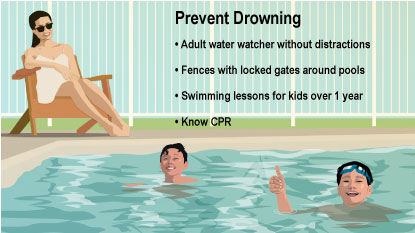After Being Underwater: How to Care for Your Child
Your child was underwater for a short time but was rescued before there was any damage to their body or brain. They were checked in the emergency room and can now be watched at home.
Fortunately, your child was rescued. But to protect them and everyone in your family, this is a good time to review water safety guidelines.


-
Watch your child over the next 2 days for any symptoms, such as cough, fever, heavy or fast breathing, or chest pain. If your child has any of these, take them back to the emergency room.
-
Your child can eat and drink as usual.
-
Your child can go back to regular activities if a responsible adult will be there to watch for symptoms.
Water Safety Guidelines
Assign a Water Watcher
The water watcher should:
-
be at least 16 years old
-
always keep their eyes on kids who are in the water, even older children who can swim
-
be within an arm's length of young children and beginner swimmers
-
avoid distractions like using a cellphone, socializing, or drinking alcohol
-
have a way to call for help if needed
-
have a flotation device and/or reaching object that can be used for a rescue
Use Fences/Alarms/Covers
-
All pools (including above-ground pools) and hot tubs should have a 4-foot or higher fence around them with a self-closing, locked gate.
-
Have door and window alarms that chime when opened to alert a parent that a child is going outside and pool alarms that go off when someone enters the pool.
-
If you can't put a fence around a pool or hot tub, be sure to securely cover them when you aren't using them. The cover should not have any standing water on it.
-
If your house has doors that lead directly into a pool or hot tub area, these should be self-closing and self-locking so that children can't open them.
Have Kids Take Swim Lessons
Check with your local recreation center or visit the Red Cross website for classes taught by a qualified instructor in your area.
Learn CPR
Visit the Red Cross website for classes taught by a qualified instructor in your area.
Use Life Jackets
Children and adults should wear Coast Guard–approved life jackets while on a boat (even if they can swim).
No Alcohol or Drugs
Do not use alcohol and/or drugs while driving a boat, acting as a water watcher, or swimming.
Home Safety
To prevent drownings in and around your home:
-
Put locks on bathroom doors and toilets. Do not let babies or toddlers be in a bathroom alone.
-
Never leave a baby or toddler alone in the bath. If you must leave the bath area, wrap your baby in a towel and bring them with you.
-
Never leave a bathtub, bucket, baby pool, or other container filled with water or other liquid unattended.
Talk to Teens
Even teens who are strong swimmers are at risk of drowning. Be sure your teen knows how to swim. And talk to them about never swimming alone, only swimming where a trained lifeguard is on duty, and never drinking alcohol or using drugs while near or in water.


Your child:
-
develops a cough, shortness of breath, rapid breathing, or trouble breathing
-
has chest pain or discomfort
-
seems pale, extremely tired, or unsteady

What happens if my child develops breathing symptoms? Because your child had little to no symptoms in the emergency room, it is very unlikely that they will get symptoms at home. But very rarely, a child can get symptoms hours after an underwater rescue. If your child gets symptoms later, they need treatment right away.
Who is most at risk of drowning? Drowning is more likely in young children, kids who don't know how to swim, kids who swim without proper adult supervision, and people who have seizures. Drinking alcohol while boating or swimming also increases the risk of someone drowning.